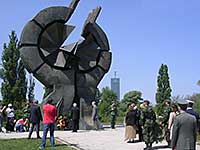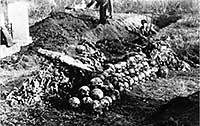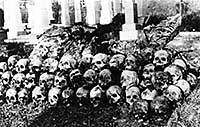| STARO SAJMISTE CAMP | ||||||||||||||||
|
||||||||||||||||
|
From Danilo Fogel's book Jewish Community in Zemun 1739 – 1945, Zemun, 2007. THE OLD FAIR (STARO SAJMISTE)– JUDENLAGER SEMLIN Although there were only a few Zemun Jews interred and killed at the old Fair - Sajmiste it is the belief of the author that this book about Zemun Jews should recount some details about this death camp. Among other, the fact that the camp was situated in the territory of the Zemun municipality is justification enough. Although the concentration camp was within the bounds of the Zemun community, the Jews of Zemun had only a vague intimation of what was happening inside the camp. Frequently at night a horse drawn cart passed along the main street heading for the cemetery. At the cemetery large collective graves were already dug up waiting for the cart load of slaughtered camp inmates to be buried inside them. Many similar events point to the fact that the true character of the Sajmiste concentration camp could not have left any doubt as to its true nature. According to the account written by Zeni Lebl, the Germans abandoned the idea to build a concentration camp on the islet near Zasavica as the river It was Dr. Harald Turner, the Chief of the administrative headquarters of the German Commander in Chief for In the period December 8-12, 1941 it was the gendarmerie of the Nedic government that made a round of Jewish flats handing out summons for registering with the Special police for Jews. It was stated in the text of the summons that they each should take with them only as much hand luggage as one could carry. Apart from this all Jews summoned to the station were obliged to hand over to the police the keys to their apartments with a tag attached stating the address. The summoned groups of Jews were thrown into open trucks which took them over the pontoon bridge to the Sajmiste. The Fair pavilions and its central dome were damaged during the German bombardment of 1941 so that snow fell in through the dilapidated roof. The prisoners were initially brought to pavilion 3 where each one of them searched for a bunk among the three tiered wooden beds. The beds were lined only with wet, rotting straw. The younger children were hungry and cold. The conditions inside the Sajmiste were inhuman. At the very beginning of its operation some 600 Gypsies had been interred inside the camp out of which 10% had died within the first three months of imprisonment. However, the rest had gradually been released from the concentration camp from January to March, 1942. The commander of the Jewish camp at Sajmiste was SS Unterstrumfuerer Herbet Andofer, born in The number of imprisoned Jews in the Sajmiste concentration camp was never established. Some sources state that on January 31, 1942 there were some 6.500 souls inside the camp. However the number of those killed must be much greater than the stated number. It is a fact that before the April war of 1941 over 12.000 Jews had been living in Women and children from other towns in The commander of the intelligence service of the German Reich in In her book “Do konacnog resenja” Zeni Lebl states that the death truck-vehicle had been designed by engineers Becker and Walter Rauf under direct orders from Himmler and that it had been manufactured in the “Sauer” factory. It was an enormous dark grey vehicle, 6 meters long, 2 wide and 1.70 high. By means of a specific device poisonous gases emitted by the running engine could be lead into the truck cargo compartment. Victims inside the air tight truck compartment would die of suffocation caused by carbon monoxide poisoning within approximately 15 minutes. This truck was driven by Wilhem Getz and Ervin Meyer, SS non-commissioned officers of the Special command. The fact later became the theme for David Albahari’s book Getz and Meyer. The first victims of death by suffocation inside this chamber were the patients and medical staff of Jewish hospitals. The execution of all Jews imprisoned in the Sajmiste concentration camp was carried out in the same way. In his statement, a grave digger from Jajinci, recounts how he had worked for two full months on the excavation of graves. The graves were actually long trenches. The number of trenches he had dug up was 81 or 82. Inside each trench round 100 Jews who had died from suffocation had been buried. From this fact it can reasonably be deducted that approximately 8.000 Jews, mostly women and children, had been suffocated inside the truck. |
||||||||||||||||



